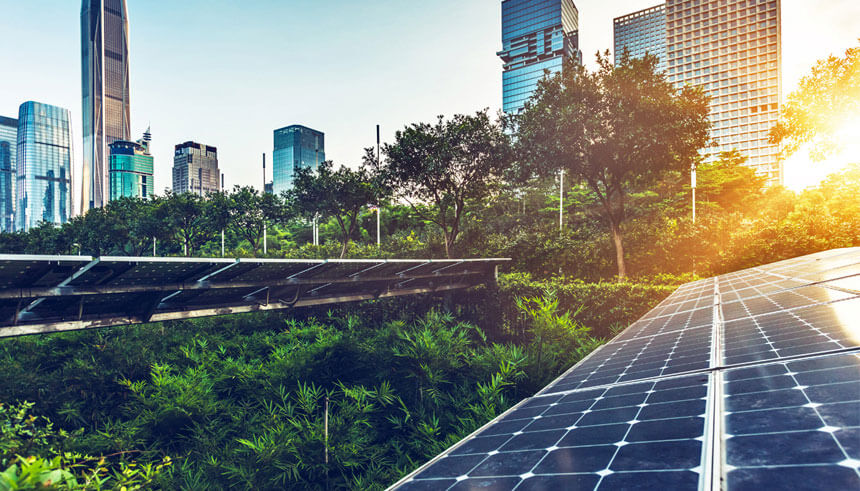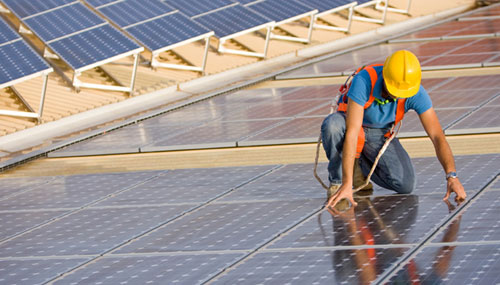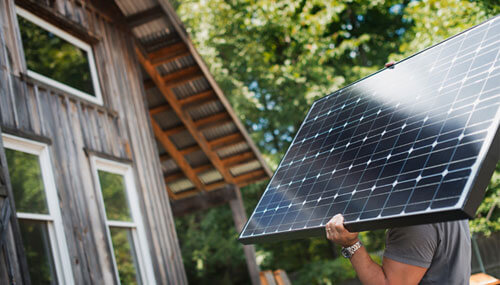U.S.-Asia Business
Renewable Energy Business Charges Ahead Amidst Trade War
By Melody Yuan

How US-China solar and renewable energy efforts keep innovating despite trade tariffs.
Renewable and clean energy are on the rise in the United States: The country now produces almost six times as much renewable electricity from the sun and the wind than it did in 2008. In 2017, the U.S. generated a record amount of solar power, amounting to more than 2 percent of its electricity mix, which is enough to power 7 million homes. Some speculate that improvements in renewable energy technology, lower costs and increased acceptance of using them have resulted in Americans using nearly 8 percent less energy today than a decade ago.
However, since President Trump took office, renewable energy has taken a hit. The administration pulled the U.S. out of the international Paris climate agreement and eased restrictions on fossil fuel, oil and coal production. The recent hike in tariffs from the Trump administration on renewable energy has been the latest blow to the industry. Specifically, the 30 percent tariff on imported solar equipment has threatened the $28 billion industry where 80 percent of its parts are made overseas. How has this move impacted domestic and cross-border business in the industry?
“If you remember about 12 months ago, solar modules were having huge ups and downs, especially with President Trump increasing the tariffs on imported modules,” says Don Danh, senior vice president and manager of emerging markets and clean technology at East West Bank. “Modules used to be sold for about 32 cents per watt, and it jumped to about 42 cents almost overnight. So imagine the price difference by increasing it 10 cents per watt—that’s essentially increasing a clean energy project by at least $100,000. By increasing the tariffs, President Trump effectively eliminated almost 70 percent of all clean energy projects here in the U.S.”
Yet despite the many hurdles that the Trump administration has tried to place along the way, the renewable energy sector continues to innovate, advance and operate. Here are some areas that are predicted to see investment growth and development.
Continued cross-border business opportunities
The renewable energy movement is global and not an industry that can thrive in isolation. “Honestly, the solar module tariffs were put into effect even before the announcement of a trade war between the U.S. and China,” says Danh. “But that didn’t stop us from doing cross-border business—we just learned to adapt.”
For East West Bank customer and clean-tech company Apparent Inc., cross-border partnerships and cooperation have only grown stronger. An example of this is Apparent and international firm BYD Auto Co., Ltd, the largest manufacturer of electric vehicles and batteries, working together to integrate more electric buses into American cities. “BYD is an impressive company with strong leadership directing opportunities for stellar technology,” says Jacqueline DeSouza, president of Apparent. “It’s a natural fit for our energy platform, and we’re exploring solutions for improving the power management of electric bus charging stations and battery systems used in commercial, industrial and residential markets. The collaboration has been great, and we’re looking forward to doing projects together.”
"Honestly, the solar module tariffs were put into effect even before the announcement of a trade war between the U.S. and China. But that didn’t stop us from doing cross-border business—we just learned to adapt.”

For Christopher Simeone, East West Bank’s commercial and industrial project finance relationship manager in New York, weaving various international and domestic companies to make a project happen is all part of the job. “We’re getting ready to construct a solar farm in Brookhaven, Long Island,” says Simeone. “It’s a 19.6 megawatt photovoltaic utility scale project that’s being constructed by Sybac Solar, which is a company based in Florida.” East West Bank will be providing construction financing, in addition to other administrative, collateral, depository and interest swapping services. Simeone was also able to incorporate JinkoSolar, a leading Chinese manufacturer of solar panels, to apply top-tier technology to the project.
“We’ve been continuing to finance cross-border projects because we still find lucrative opportunities here,” says Danh. “I mean, just [a few] months ago, there were big changes in the industry again.” Danh is referring to the sudden drop in price of solar panels and modules in June. “This time around, the modules are going in reverse and getting cheaper because, in response to the tariffs, President Xi Jinping decided to slow down the production of new solar projects in China,” says Danh. “So now all of a sudden, you have a massive overflow of modules that have already been manufactured for China, but now have nowhere else to go.” Danh expects that over the course of the next 12 months, the industry will see a dramatic shift in pricing that will cause solar module prices to potentially drop even lower than when the tariffs first took effect.
Energy battery storage and waste-to-energy
One of the biggest challenges facing solar energy is battery storage capacity. While there are many product and capacity specifications to consider, battery life and efficiency have improved considerably since renewable energy batteries, especially in regard to solar, first hit the market.
“We’ve developed an energy network that can manage the energy and data needs of an individual consumer or a network of consumers when connected to distributed energy resource (DER) assets,” says DeSouza. “We plan to use our DER assets and energy network to offer consumers utilities options to subscribe for energy and data services that fit their needs. Apparent’s energy network offers real-time data collection dispatch and control, as well as better-managed energy storage and charging, all of which will definitely help with the overall initiative.”
With bigger consumer demand for renewable energy, more companies are investing in and running trial projects around options for energy storage. “We’re going to see improved power grids and higher values in energy storage capacities,” says Danh.
Waste management for cities continues to become a strain, as China recently announced a trash import ban earlier this year. With Beijing no longer buying recyclable materials and trash, waste management companies and cities are looking for innovative ways to effectively manage piling waste.
“We’ve actually been talking with Biostar since they were contacted by a food processor in California with a request to build a facility to recycle waste,” says Danh. Unknown to most residents, electricity is actually generated as a byproduct of processing and recycling waste. “If this project goes through, the facility would sell 30 percent of its energy to SoCal Edison, in addition to processing the food waste,” says Danh. “They could also sell gas and fertilizers to agriculture, since those are byproducts of the process as well.”
China has also ramped up its efforts to transform waste to energy as China Everbright International secured its twenty-first waste-to-energy project by investing $55 million in Shandong Province.
“What will be interesting is seeing how these applications are deployed around the world, especially in China and Asia, to leapfrog aspects of the developed energy markets that have been exhausted or no longer make sense,” says DeSouza.
The role of the consumer
While much of the renewable energy industry in the U.S. has been driven by state-mandated policies, demands for sustainable energy production from individual consumers have begun to really take off. “The energy market is undergoing a transformation in moving from centralized capital assets, to distributed assets and services,” says DeSouza. “This shift encourages individuals to participate in the energy market as producers, as well as better-informed, active consumers.”

“The energy market is undergoing a transformation in moving from centralized capital assets to distributed assets and services. This shift encourages individuals to participate in the energy market as producers as well as better-informed, active consumers.”
The City of Davis serves as a great example. “The city adopted a renewable energy plan and a goal to be 100 percent carbon neutral by 2050,” says DeSouza. With the state of California planning to derive 50 percent of its energy from renewable sources by 2030, innovation in this industry has been more productive than ever. “Apparent’s development of PVUSA, a historic solar electricity production and equipment testing site, has been central to Davis’ renewable energy plan and carbon neutral goal,” DeSouza continues. “Using Apparent’s technology, PVUSA produces renewable solar energy, and then exports energy to both the PG&E distribution grid and the California Independent System Operator’s transmission grid.” The exported energy is then credited against the City of Davis’ utility accounts, so that the city can decrease its costs and better manage their energy demands and supplies.
“We at Apparent are trying to innovate to help decentralize the energy markets and allow consumers to produce, manage, buy and sell energy in the form that they want,” says DeSouza. Using examples such as the shift in telecommunications and computer networking from phone booths and desktops, to smart phones and tablets spawning new markets and greater opportunities, DeSouza sees this current trend as the golden age of renewable energy. “The development of much more integrated energy systems that allow consumers to produce, interconnect, manage, and sell energy creates new markets for energy services,” she says.
Current tariffs and the future of renewable energy
“The industry will inevitably be affected by any sort of tariff change,” says Simeone. “But what we’ve seen over the past decade, and more so in the last several years, is that there’s been a constant decrease in the cost of investing and operating in the renewable energy space. The economics in developing new projects are still very constructive for many developers despite the tariffs.”
A recent study led by the Department of Energy’s National Renewable Energy Laboratory found that an 80 percent renewables future is possible with today’s technology, which includes solar photovoltaics, biopower, wind turbines, hydropower and geothermal energy. With the costs of solar power declining by 85 percent, and wind power costs declining by roughly half in the last decade, some experts are speculating that clean energy may actually be cheaper to generate than coal or fossil fuels.
“In the U.S., we are faced with the problems of meeting consumer demand, regulatory, and legislative mandates that are pushing for more renewable energy assets against very real national security issues, an aging grid, and a slow-moving utility business model,” says DeSouza.
Given that renewable energy has seen long-term global growth and consumers are demonstrating a greater awareness of climate change and willingness to consume energy responsibly, experts in this industry are optimistic about the future of renewables.
“If you have the knowledge and expertise in your field, you won’t freak out when there are changes,” says Danh. “When President Trump makes a crazy statement, if there’s a trade war between China and the U.S., or even if they come down on a particular sector, it’s your job not only to survive, but to thrive despite the circumstances.”

